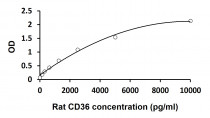ARG81877
Rat CD36 ELISA Kit
Rat CD36 ELISA Kit for ELISA and Rat
Component
| Cat No | Component Name | Package | Temp |
|---|---|---|---|
| ARG81877-001 | Antibody-coated microplate | 8 X 12 strips | 4°C. Unused strips should be sealed tightly in the air-tight pouch. |
| ARG81877-002 | Standard | 2 X 10 ng/vial | 4°C |
| ARG81877-003 | Standard/Sample diluent | 30 ml (Ready to use) | 4°C |
| ARG81877-004 | Antibody conjugate concentrate (100X) | 1 vial (100 µl) | 4°C |
| ARG81877-005 | Antibody diluent buffer | 12 ml (Ready to use) | 4°C |
| ARG81877-006 | HRP-Streptavidin concentrate (100X) | 1 vial (100 µl) | 4°C |
| ARG81877-007 | HRP-Streptavidin diluent buffer | 12 ml (Ready to use) | 4°C |
| ARG81877-008 | 25X Wash buffer | 20 ml | 4°C |
| ARG81877-009 | TMB substrate | 10 ml (Ready to use) | 4°C (Protect from light) |
| ARG81877-010 | STOP solution | 10 ml (Ready to use) | 4°C |
| ARG81877-011 | Plate sealer | 4 strips | Room temperature |
Overview
| Product Description | ARG81877 Rat CD36 ELISA Kit is an Enzyme Immunoassay kit for the quantification of Rat CD36 in serum, plasma (heparin, EDTA) and cell culture supernatants. |
|---|---|
| Tested Reactivity | Rat |
| Tested Application | ELISA |
| Specificity | There is no detectable cross-reactivity with other relevant proteins. |
| Target Name | CD36 |
| Conjugation | HRP |
| Conjugation Note | Substrate: TMB and read at 450 nm. |
| Sensitivity | 78 pg/ml |
| Sample Type | Serum, plasma (heparin, EDTA) and cell culture supernatants. |
| Standard Range | 156 - 10000 pg/ml |
| Sample Volume | 100 µl |
| Precision | Intra-Assay CV: 7.0%; Inter-Assay CV: 7.4% |
| Alternate Names | GPIV; CHDS7; Platelet glycoprotein 4; CD antigen CD36; PAS-4; PASIV; Glycoprotein IIIb; PAS IV; GPIIIB; FAT; SCARB3; GP3B; Leukocyte differentiation antigen CD36; Platelet collagen receptor; BDPLT10; Thrombospondin receptor; GP4; Fatty acid translocase; Platelet glycoprotein IV |
Application Instructions
| Assay Time | ~ 5 hours |
|---|
Properties
| Form | 96 well |
|---|---|
| Storage Instruction | Store the kit at 2-8°C. Keep microplate wells sealed in a dry bag with desiccants. Do not expose test reagents to heat, sun or strong light during storage and usage. Please refer to the product user manual for detail temperatures of the components. |
| Note | For laboratory research only, not for drug, diagnostic or other use. |
Bioinformation
| Gene Symbol | CD36 |
|---|---|
| Gene Full Name | CD36 molecule (thrombospondin receptor) |
| Background | The protein encoded by this gene is the fourth major glycoprotein of the platelet surface and serves as a receptor for thrombospondin in platelets and various cell lines. Since thrombospondins are widely distributed proteins involved in a variety of adhesive processes, this protein may have important functions as a cell adhesion molecule. It binds to collagen, thrombospondin, anionic phospholipids and oxidized LDL. It directly mediates cytoadherence of Plasmodium falciparum parasitized erythrocytes and it binds long chain fatty acids and may function in the transport and/or as a regulator of fatty acid transport. Mutations in this gene cause platelet glycoprotein deficiency. Multiple alternatively spliced transcript variants have been found for this gene. [provided by RefSeq, Feb 2014] |
| Function | Binds to collagen, thrombospondin, anionic phospholipids and oxidized low-density lipoprotein (oxLDL). May function as a cell adhesion molecule. Directly mediates cytoadherence of Plasmodium falciparum parasitized erythrocytes. Binds long chain fatty acids and may function in the transport and/or as a regulator of fatty acid transport. Receptor for thombospondins, THBS1 AND THBS2, mediating their antiangiogenic effects. As a coreceptor for TLR4-TLR6 heterodimer, promotes inflammation in monocytes/macrophages. Upon ligand binding, such as oxLDL or amyloid-beta 42, rapidly induces the formation of a heterodimer of TLR4 and TLR6, which is internalized and triggers inflammatory response, leading to NF-kappa-B-dependent production of CXCL1, CXCL2 and CCL9 cytokines, via MYD88 signaling pathway, and CCL5 cytokine, via TICAM1 signaling pathway, as well as IL1B secretion. [UniProt] |
| Highlight | Related products: CD36 antibodies; CD36 ELISA Kits; CD36 Duos / Panels; New ELISA data calculation tool: Simplify the ELISA analysis by GainData |
| PTM | N-glycosylated and O-glycosylated with a ratio of 2:1. Ubiquitinated at Lys-469 and Lys-472. Ubiquitination is induced by fatty acids such as oleic acid and leads to degradation by the proteasome (PubMed:21610069, PubMed:18353783). Ubiquitination and degradation are inhibited by insulin which blocks the effect of fatty acids (PubMed:18353783). [UniProt] |
Images (1) Click the Picture to Zoom In
| Title | Download Link |
|---|---|
| ARG81877 Rat CD36 ELISA Kit User's manual |
 Download Download
|






